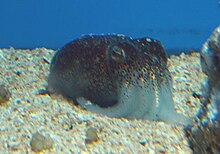Sepiolina nipponensis
Appearance
| Sepiolina nipponensis | |
|---|---|

| |
| Scientific classification | |
| Domain: | Eukaryota |
| Kingdom: | Animalia |
| Phylum: | Mollusca |
| Class: | Cephalopoda |
| Order: | Sepiolida |
| Family: | Sepiolidae |
| Subfamily: | Heteroteuthidinae |
| Genus: | Sepiolina |
| Species: | S. nipponensis
|
| Binomial name | |
| Sepiolina nipponensis | |
| Synonyms | |
|
Stoloteuthis nipponensis Berry, 1911 | |
Sepiolina nipponensis, also known as the Japanese bobtail squid, is a bobtail squid and one of two species in the genus Sepiolina. It is found in the Western Pacific in apparently widely separated populations, the most southerly of which is in the Great Australian Bight in South Australia and Western Australia, and there are populations from the Philippines northwards to Taiwan, Fujian and southern Honshū.[1]
Description
[edit]The maximum size of adult Japanese bobtail squid is 2.5 cm in mantle length.[3] The body consists of large fins and a short and dome-shaped mantle surrounded by an iridescent belt. The mantle cavity contains subcordate luminous organs. The arms are subequal with biserial suckers.
References
[edit]- ^ a b Allcock, L.; Barratt, I. (2012). "Sepiolina nipponensis". IUCN Red List of Threatened Species. 2012: e.T162521A908353. doi:10.2305/IUCN.UK.2012-1.RLTS.T162521A908353.en. Retrieved 18 November 2021.
- ^ Julian Finn (2016). "Sepiolina nipponensis (Berry, 1911)". World Register of Marine Species. Flanders Marine Institute. Retrieved 10 February 2018.
- ^ "Sea Life Base".
- Sweeney, M. J. and C. F. E. Roper / N. A. Voss, M. Vecchione, R. B. Toll and M. J. Sweeney, eds. (1998). Classification, type localities and type repositories of recent Cephalopoda, Systematics and Biogeography of Cephalopods. Smithsonian Contributions to Zoology, 586 (I-II).

